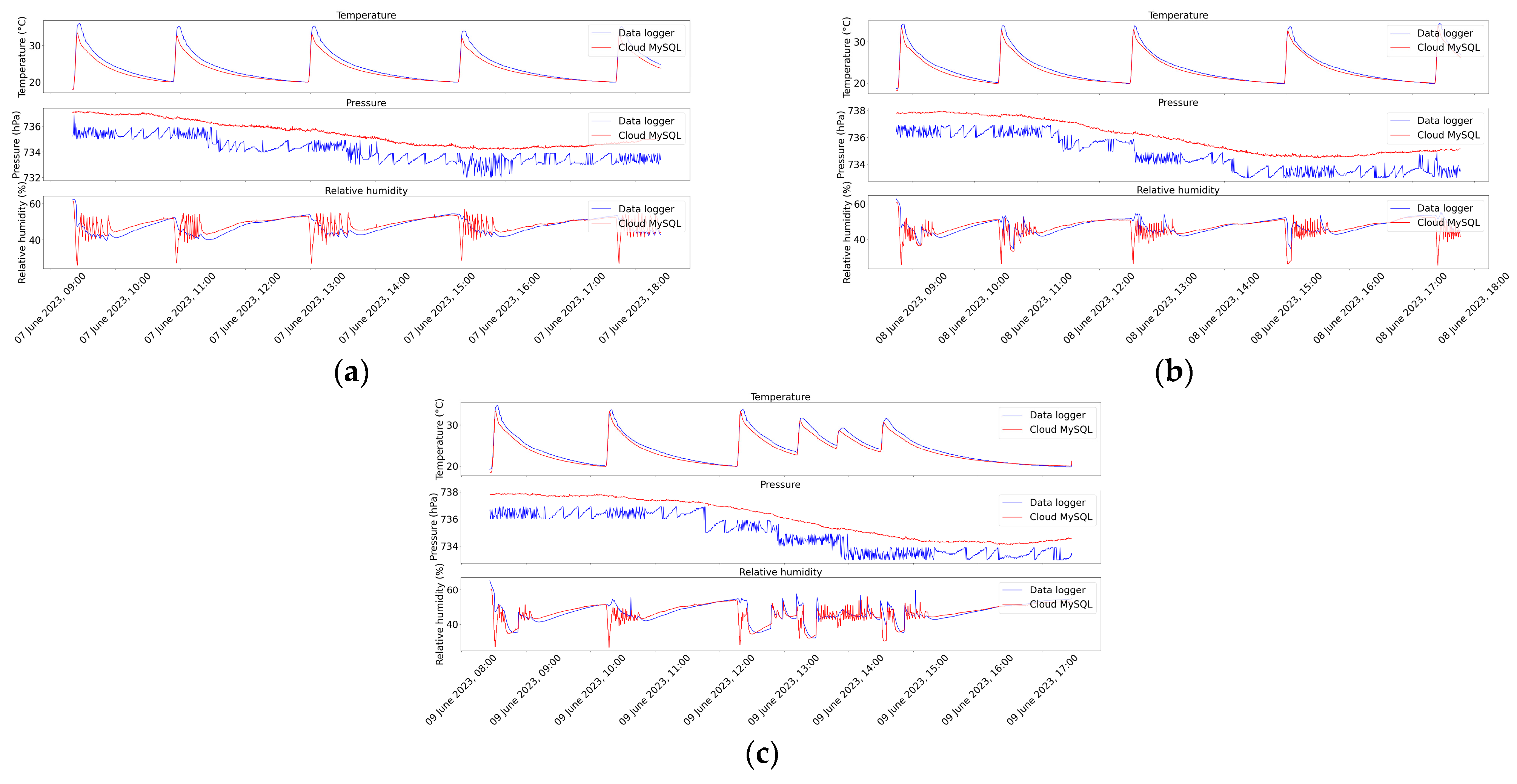Implementation of A Data-Acquisition System and Its Cloud-Based Registration Using the Unified Architecture of Open Platform Communications †
Abstract
:1. Introduction
2. General Definitions
3. State of the Art Study
4. Development of the Proposal
4.1. OPC UA Server Configuration
4.2. OPC UA Client Configuration
4.3. Platform Configuration
5. Results and Discussion
5.1. Testing Connection with OPC UA and Proposed Services
5.2. Results of OPC UA Implementation and Proposed Services
6. Conclusions
Author Contributions
Funding
Institutional Review Board Statement
Informed Consent Statement
Data Availability Statement
Conflicts of Interest
References
- Sodhi, H. When industry 4.0 meets lean six sigma: A review. Ind. Eng. J. 2020, 13, 1–12. [Google Scholar] [CrossRef]
- Gallo, T.; Cagnetti, C.; Silvestri, C.; Ruggieri, A. Industry 4.0 tools in lean production: A systematic literature review. Procedia Comput. Sci. 2021, 180, 394–403. [Google Scholar] [CrossRef]
- Drahos, P.; Kucera, E.; Haffner, O.; Klimo, I. Trends in industrial communication and OPC UA. In 2018 Cybernetics & Informatics (K&I); IEEE: Piscataway, NJ, USA, 2018; pp. 1–5. [Google Scholar] [CrossRef]
- Schwarz, M.H.; Borcsok, J. A survey on OPC and OPC-UA: About the standard, developments and investigations. In Proceedings of the 2013 XXIV International Conference on Information, Communication and Automation Technologies (ICAT), Sarajevo, Bosnia and Herzegovina, 30 October–1 November 2013; IEEE: Piscataway, NJ, USA; pp. 1–6. [Google Scholar] [CrossRef]
- Kim, S.-M.; Choi, Y.; Suh, J. Applications of the Open-Source Hardware Arduino Platform in the Mining Industry: A Review. Appl. Sci. 2020, 10, 5018. [Google Scholar] [CrossRef]
- McIlvride, B.; Thomas, A.; Real, C. OPC Tunnelling–Know Your Options; Cogent Real-Time Systems Inc.: Mississauga, ON, Canada, 2008. [Google Scholar]
- Mahnke, W.; Leitner, S.-H.; Damm, M. OPC Unified Architecture; Springer Science & Business Media: Berlin, Germany, 2009. [Google Scholar]
- Vimos, V.; Sacoto Cabrera, E.J. Results of the implementation of a sensor network based on Arduino devices and multiplatform applications using the standard OPC UA. IEEE Lat. Am. Trans. 2018, 16, 2496–2502. [Google Scholar] [CrossRef]
- Muller, M.; Wings, E.; Bergmann, L. Developing open source cyber-physical systems for service-oriented architectures using OPC UA. In Proceedings of the 2017 IEEE 15th International Conference on Industrial Informatics (INDIN), Emden, Germany, 24–26 July 2017; IEEE: Piscataway, NJ, USA; pp. 83–88. [Google Scholar] [CrossRef]
- Pena, R.R.; Fernandez, R.D.; Lorenc, M.; Cadiboni, A. Gateway OPC UA/Modbus applied to an energy recovery system identification. In Proceedings of the 2019 XVIII Workshop on Information Processing and Control (RPIC), Bahia Blanca, Argentina, 18–20 September 2019; IEEE: Piscataway, NJ, USA; pp. 235–240. [Google Scholar] [CrossRef]
- Kambezidis, H.D. The Solar Resource. In Comprehensive Renewable Energy; Elsevier: Amsterdam, The Netherlands, 2012; pp. 27–84. [Google Scholar] [CrossRef]



| Interval | Variable | Devices | Records | Mean | RMSE |
|---|---|---|---|---|---|
| 10 s | Temperature (°C) | RHT35 | 1128 | 23.85 | 1.44 |
| Cloud | 2951 | 23.26 | |||
| Pressure (hPa) | RHT35 | 1128 | 734.15 | 1.36 | |
| Cloud | 2951 | 735.41 | |||
| Humidity (%) | RHT35 | 1128 | 47.86 | 4.52 | |
| Cloud | 2951 | 48.25 | |||
| 20 s | Temperature (°C) | RHT35 | 1091 | 23.67 | 1.02 |
| Cloud | 1543 | 23.13 | |||
| Pressure (hPa) | RHT35 | 1091 | 734.77 | 1.33 | |
| Cloud | 1543 | 736.04 | |||
| Humidity (%) | RHT35 | 1091 | 47.49 | 4.21 | |
| Cloud | 1543 | 46.64 | |||
| 30 s | Temperature (°C) | RHT35 | 1085 | 24.29 | 0.94 |
| Cloud | 1043 | 23.68 | |||
| Pressure (hPa) | RHT35 | 1085 | 734.91 | 1.21 | |
| Cloud | 1043 | 736.06 | |||
| Humidity (%) | RHT35 | 1085 | 46.95 | 4.02 | |
| Cloud | 1043 | 46.16 |
Disclaimer/Publisher’s Note: The statements, opinions and data contained in all publications are solely those of the individual author(s) and contributor(s) and not of MDPI and/or the editor(s). MDPI and/or the editor(s) disclaim responsibility for any injury to people or property resulting from any ideas, methods, instructions or products referred to in the content. |
© 2023 by the authors. Licensee MDPI, Basel, Switzerland. This article is an open access article distributed under the terms and conditions of the Creative Commons Attribution (CC BY) license (https://creativecommons.org/licenses/by/4.0/).
Share and Cite
Molina, A.; Vargas, D.; Rodas, A. Implementation of A Data-Acquisition System and Its Cloud-Based Registration Using the Unified Architecture of Open Platform Communications. Eng. Proc. 2023, 47, 20. https://doi.org/10.3390/engproc2023047020
Molina A, Vargas D, Rodas A. Implementation of A Data-Acquisition System and Its Cloud-Based Registration Using the Unified Architecture of Open Platform Communications. Engineering Proceedings. 2023; 47(1):20. https://doi.org/10.3390/engproc2023047020
Chicago/Turabian StyleMolina, Anthony, Diego Vargas, and Ana Rodas. 2023. "Implementation of A Data-Acquisition System and Its Cloud-Based Registration Using the Unified Architecture of Open Platform Communications" Engineering Proceedings 47, no. 1: 20. https://doi.org/10.3390/engproc2023047020
APA StyleMolina, A., Vargas, D., & Rodas, A. (2023). Implementation of A Data-Acquisition System and Its Cloud-Based Registration Using the Unified Architecture of Open Platform Communications. Engineering Proceedings, 47(1), 20. https://doi.org/10.3390/engproc2023047020






